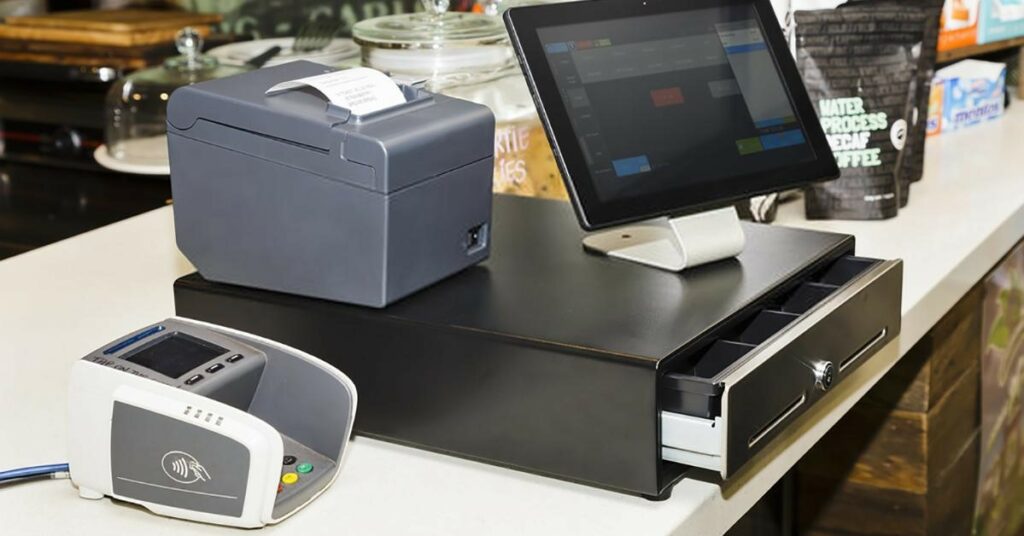The Future Outlook of Information Systems in Business
Computers and information systems are used by businesses to cut costs and obtain a competitive advantage in the marketplace. You are surrounded by many computer and information system applications that are utilized in everyday life.
Mục Lục
Information systems in Business
Computers and information systems are commonly used in grocery and retail stores as well. For example, a point-of-sale (POS) system speeds up service by reading the universal product codes (UPCs) on items in your shopping cart (see image below). This same system also manages store inventory, and some information systems can even reorder stock automatically. Banks, too, use computers and information systems for generating monthly statements, running automatic teller machines (ATMs), and for many other banking activities.

A point of sale system
The Internet is used for all kinds of activities, from shopping to learning to working. Search engines and broadband communication bring information to one’s desktop in seconds. The Internet is also used for social purposes. Organizations also use social networking sites to give customers up-to-date information and how-to support via videos. These sites can reduce organizations’ costs by providing an inexpensive medium for targeting a large customer base.
So what do all these examples mean to you? As you read, keep in mind that the terms information systems and information technologies are used interchangeably. Information systems are broader in scope than information technologies, but the two overlap in many areas. Both are used to help organizations be more competitive and to improve their overall efficiency and effectiveness. Information technologies offer many advantages for improving decision making but involve some challenges, too, such as security and privacy issues.
Outlook for the Future

Predictions for the information systems by examining various factors related to their design, implementation and usage in business
- Hardware and software costs will continue to decline, so processing information will be less expensive. These cost savings should make information systems affordable for any organization, regardless of its size and financial status.
- Artificial intelligence and related technologies will continue to improve and expand, which will have an impact on information systems. For example, further development in natural language processing should make information systems easier to use. Also, robots will play a major role in the workforce of the future. According to Gartner, by 2025, software or robots will be in charge of one out of three jobs.
- The computer literacy of typical information system users will improve, as computer basics are taught more in elementary schools.
- Networking technology will improve, so connecting computers will be easier and sending information from one location to another will be faster. Compatibility issues between networks will become more manageable, and integrating voice, data, and images on the same transmission medium will improve communication quality and information delivery.
- Personal computers and tablets will continue to improve in power and quality, so most information system software will be able to run on them without problems. This trend should make information systems more affordable, easier to maintain, and more appealing to organizations.
- Internet growth will continue, which will put small and large organizations on the same footing, regardless of their financial status. Internet growth will also make e-collaboration easier, despite geographical distances.
- Computer criminals will become more sophisticated and protecting personal information will become more difficult.
Major computing trends that are already underway and would continue
- Ubiquitous computing: Computing devices everywhere with different sizes and power and accessed through multiple formats such as voice, touch, and gesture
- The Internet of Things (IoT), the Internet of Everything (IoE), and the Internet of Me (IoM): Connected devices through the Web that will be used by businesses and individuals for increasing productivity and cost savings
3D and 4D printing: Creating a physical object from a 3D and 4D digital model for individual use and businesses. This could significantly bring down manufacturing costs - Pervasive analytics: Building and integrating analytics capabilities into all everyday business activities
- Context-aware computing: Widespread applications and deployment of devices that know users, their devices, and their locations and serve as intelligent assistants to businesses and individuals
- Smart machines and devices: Continuous improvements in autonomous cars, trucks, drones, and robots, such as self-driving cars
- Cloud computing: Growth in cloud computing for multiple applications and multiple users
Software-defined applications and infrastructures: The trend toward dynamically assembled infrastructures that are more responsive to user needs and able to deliver results faster, as opposed to predefined infrastructures. - Security: The importance of computer and network security will increase, and more attention will be given to application self-protection
Wrap up
Again, these trends are showing what businesses can embrace in the future to reduce costs, increase efficiency, and gain a competitive edge in the marketplace. If you are planning to create software for your organization, or developing a Software-as-a-Service that all other businesses need, and you need a reliable tech partner, do not hesitate to contact us. We’re fram^ – a leading software development company in Vietnam.















![Toni Kroos là ai? [ sự thật về tiểu sử đầy đủ Toni Kroos ]](https://evbn.org/wp-content/uploads/New-Project-6635-1671934592.jpg)


